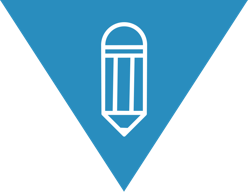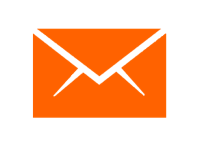Did you know that a full 98% of the general public prepares their resume incorrectly? That's because resume writing is an art and a science that takes even professional resume writers years to perfect.
Evelyn Salvador ensures your resume is precisely targeted to the position(s) you seek, your qualifications match the job requirements, all of the critical resume keywords are incorporated, and your benefits and achievements provide your prospective employers with a high value proposition.
Evelyn’s resumes increase your interview odds, heighten your confidence level, help you gain renewed enthusiasm for the job search, make you feel empowered in the interview stage, and help you land the position you seek sooner—and at your highest salary potential.

Executive Resumes are professionally written and graphically designed to personally brand you in your profession. As a Personal Branding Pioneer and the world leader in resume design since 1992, Evelyn Salvador Identifies and defines your personal brand to include all of your features, benefits, competitive edge, value proposition, and ROI that compels hiring managers to contact you before your competitors; and she ensures your resume includes your matching achievements.
RESUME: $1295
COVER LETTER: $245

The following list of resume requirements for successful resumes focuses on all of the critical resume and cover letter areas to make your presentation the best it can be in order to maximize your interview odds and salary potential.
These are the areas Evelyn personally includes in all of her clients’ resumes.
If you wonder how all these components can be included, think about the value proposition your resume will provide you, and allow Evelyn to write your interview-generating resume.

A building is only as strong as the foundation on which it sits. Similarly, resume strategy is key in developing your resume to ensure it is a success. Your overall resume should precisely target the position for which you seek, any "red flags" must be skillfully handled, and it should portray how you can help prospective employers reach their goals by providing a high value proposition.
CRITERIA CHECKLIST
Your Cover Letter, if written well in marketing-savvy language, will attract your audience to want to read your resume and can even compel prospective employers to call you in for an interview based on your cover letter's content alone.
CRITERIA CHECKLIST
16. The first paragraph attracts your audience via your personal brand message (your assets, benefits, competitive edge, value proposition, and return on investment) or other “wow” factor.
17. First paragraph also includes position sought and where heard of.
18. The second paragraph explains what you have to offer through your matching qualifications and value proposition.
19. The third paragraph validates your value proposition by summarizing your related achievements.
20. The fourth (optional) paragraph sparks additional interest via a related story or eye-opening comment that shows hiring managers why you are interested in the position.
21. The last paragraph closes with a statement of interest, includes your call-to-action, and thanks the reader.
22. Overall cover letter uses benefit-driven sentences to entice the reader to want to read your resume, and if it’s a really good cover letter, to call you in for an interview before even reading the resume.
23. Shows how you are a match for a position opening by including all of the requirements in the original job posting and noting your expertise and qualifications in these areas.
24. Portrays how you can help prospective employers reach their goals with an explanation of how your assets and benefits can serve the firm.
25. Provides a human touch for the person behind the piece of paper so hiring managers can envision you in their firm performing the position they need filled.
26. Cover letter should be kept to within one page (4 to 5 paragraphs work well).
27. Summarizes your major achievements in brief statements, substantiates how you can be an asset to their firm, and sells you as a qualified candidate based on your experience, education, skills, and qualifications.
28. Entire cover letter is written in marketing-savvy language with persuasive statements that make hiring managers want to meet with you, including many employer benefits.
29. States what your return on investment is to prospective employers if they were to hire you.
30. Includes all of your primary industry-specific keywords. (Check Job Descriptions found on the Internet for your position title, and include all keywords in which you have experience.)
31. Includes specific ways you might be able to help the prospective employers.
32. Contains any additional compelling information as to why this particular field or position is important to you.
The “Professional Summary” section is an encapsulated first paragraph of your resume that states what you have to offer in concise format. The purpose of this section is to match your qualifications with your prospective employers’ requirements, to demonstrate you are a good fit for the position you seek, and to invite the reader in to want to read the rest of your resume.
CRITERIA CHECKLIST
33. “Professional Summary” is well constructed and summarizes your experience in a nutshell (one to two paragraphs works well).
34. Includes your Personal Brand Message (your assets, benefits, competitive edge, value proposition, and return on investment).
35. Invites the reader to want to read the rest of your resume.
36. States your targeted position in the first sentence (so it is not necessary to include an “Objective” section in your resume).
37. All primary targeted skills, attributes, and qualifications are included.
38. Primary personal attributes are included within your "Professional Summary" section.
39. Matches your qualifications with the prospective employers’ requirements to demonstrate you are a good fit for the position you seek.
40. Includes all of the primary keywords for the targeted position.
41. Contains heavy-hitting, marketing-savvy, and impactful statements.
42. Includes good use of varied sentence types that entice reader to want to read the rest of your resume.
Many firms scan in resumes to search for all relative keywords that match the targeted position opening to see if you are a qualified candidate. The purpose of including resume keywords is to pass the first electronic screening of your resume so that it is put in the hands of a hiring manager. If your resume does not include all relative keywords, it may not be read or even seen by a human.
CRITERIA CHECKLIST
43. All related keywords are including in list form under an “Areas of Experience” section of your resume right under your “Professional Summary” section.
44. Infuses all the important industry-specific keywords for your profession within your resume and cover letter.
45. Profession-specific keywords are included within responsibility bullets wherever applicable.
46. Targeted and transferable skills are also included.
47. All technical skills / computer proficiencies pertinent to position are identified and included.
Most job seekers who prepare their own resumes just list their job functions under each employer. That's what job descriptions are for. Your resume, on the other hand, must showcase how well you accomplished these job functions in order to demonstrate that you are a qualified candidate for the position, or it will not generate many interviews.
Achievements are by far the most important part of your resume (and when done correctly, will target the position you seek, include all relative keywords, and showcase measurable employer benefits).
CRITERIA CHECKLIST
48. Job years are placed to best advantage (before job title if there are no employment gaps; tucked at end of employment line if gaps area evident).
49. Primary profession-specific bullets start with responsibilities that target the position you seek.
50. Action verbs are used (in their natural sequence) to start each resume bullet (such as "Develop, implement, and monitor...").51. Resume bullets for each position are in good sequential order (most relevant bullets appear first, companion bullets thereafter, less important bullets last) relative to the targeted position you seek.
52. Wherever possible resume does not show job hopping. Jobs held for less than a year can be omitted if unrelated to position sought and no employment gap (in years) is shown.
53. .The number of jobs included in your resume does not exceed 5, or when there are more, they are categorized differently to give the look of 5 or less.
54. Job promotions are included and skillfully handled and/or progressive experience in your field is evident, if applicable.
55. Management or supervisory bullets, if applicable, are included to demonstrate how well you can lead, manage, and train and develop a staff.
56. Bland job function bullets are converted into action-packed CAR (Challenge-Action-Result) achievement statements. They state the challenge you were faced with, the action you took to meet that challenge, and the benefits your employer derived from your efforts.
57. Job functions are quantified with measurable employer benefits (how much, how many, how big, how fast, how well, how often—in dollar amounts and percentages).
58. Current and most relevant positions contain the most bullets; older and less relevant positions contain fewer bullets.
59. Bullets are worked up comprehensively so anyone who reads your resume has a full understanding of what you accomplished.
60. Each achievement bullet is concisely edited down to its "lowest common denominator" so it is impactful and does not leave out any important content.
61. Bullet line length is varied from one to three (or four-if necessary) lines throughout.
62. Resume includes a "Key Accomplishments" section when achievements are many (such as for Executives and technical positions).
For your resume to stand out and be read, it must first attract interest. Using graphic elements and rules and a resume format and design that invites the reader in will help it to stand out from your competition and get read.
CRITERIA CHECKLIST
63. Resume immediately attracts attention through exceptional formatting and design that helps it stand out from your competition and entices the reader to want to read your resume.
64. Incorporates effective marketing, design, and presentation strategies.
65. Resume design is suitable for your profession and targeted market.
66. Placement of most important information (that which targets your audience and the position you seek) is in the top one-third of your resume.
67. Job titles clearly indicated (bold and in caps).
68. Proper use of fonts and font sizes has been applied for headings and body copy.
69. There is good organization and division of material and content flows well.
70. Important information is bold-faced (section titles, job titles, employers).
71. There is sufficient white space around content so resume does not look crowded.
72. Individual pages end with full paragraphs, or better, full positions.
73. Spacing is consistent throughout and formatting looks professional.
74. Resume sections organized and titled well (Professional Summary, Areas of Expertise, Key Accomplishments, Professional Experience, Education, etc.).
75. Contact information is clear and readable (be sure to verify accuracy).
All relative education and additional training are important to include in your resume. The way your education is presented plays an important part in your resume.
CRITERIA CHECKLIST
76. Education includes college or university name, town and state, and degree received (or related coursework, if none).
77. Include Grade Point Average if 3.0 or above or GPA in major when overall GPA is less than 3.0 and it is higher. Otherwise omit GPA altogether.
78. Year of completion included if within the past 10-15 years; omitted if earlier in life.
79. All Degrees included except when both a Bachelor's and Associate's Degree have been attained, in which case the Associate's Degree can be omitted.
80. When a new grad, education belongs up front. When experience is more relative than education, education belongs towards the end of the resume.
81. Any additional training you received related to your targeted position is included in your resume. Include training course titles and where received. Add years attained if recent.
There are few—if any—excusable mistakes allowable in a resume. Grammar, punctuation, and spelling are not any of them. Many firms toss resumes with misspellings and misuse of grammar and punctuation. Be sure your resume has no typos and each sentence flows well.
CRITERIA CHECKLIST
82. Information is comprehensive but concise; one gets a complete understanding of what you are capable of and have achieved in your career as it has been explained well.
83. Resume is edited down without losing content. Every word counts.
84. Your resume does not include any personal pronouns. ("I," "me," and "my" are understood and do not belong in resumes.)
85. Action verbs start off each resume bullet and are used correctly (unless they are preceded by an adjective to show how well you handled that function). Such as “Finitely edited…”
86. Redundant or superfluous words are eliminated.
87. Irrelevant information is removed/not evident.
88. Bullets are prioritized within each position in order of their importance to the targeted profession.
89. Quantifying information (in numbers preferably) is included wherever possible.
90. Descriptive adjectives or adverbs are included, but not overused.
91. Your resume and cover letter contains powerful, persuasive marketing phrases.
92. Personal information (marriage status, children, etc.) is left out.
93. Engages reader and maintains interest through well-written content, compelling copy, and concise editing.
Although I list this last, it is THE most important component of your resume. Personal Branding is critical in today’s world of work. It sets you apart from your competition and actually helps put you in the top 2% of candidates who are called for interviews and receive job offers. Learn what it is and how to use it.
CRITERIA CHECKLIST
94. In today’s world of work, your cover letter must include all elements of your personal brand: assets, benefits, competitive edge, value proposition, and return on investment.
95. Your personal brand message is finitely written and edited and makes a “wow” statement in your cover letter.
96. Your resume must back up your personal brand with matching achievements.
97. Good use of Visual Branding (Occupational Icon™, graphic elements, charts, graphs, work samples, etc.) is contained within your cover letter and resume.
98. Good use of Verbal Branding (slogan, testimonials, mission statement, success stories, case studies, etc.) is included in your cover letter and resume.
99. Proofread and spell-check everything before you consider it done.
100. When you read your finalized resume and cover letter, you say “Wow! I’d hire me!”

Here’s to
Hearing the Words
!”You’re Hired"


